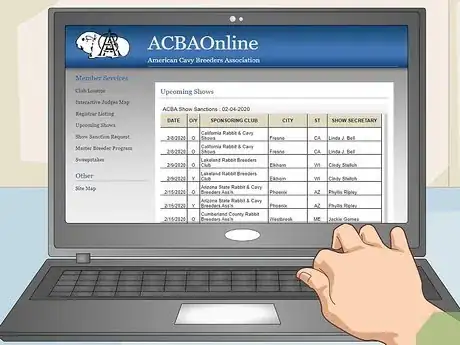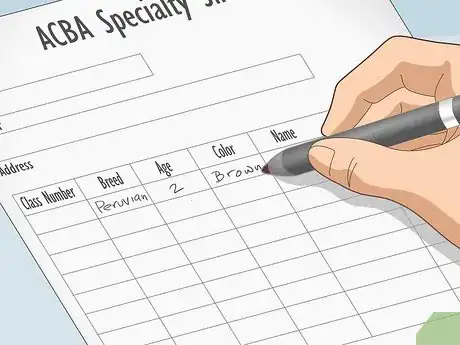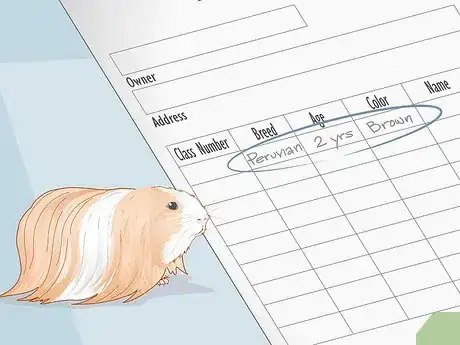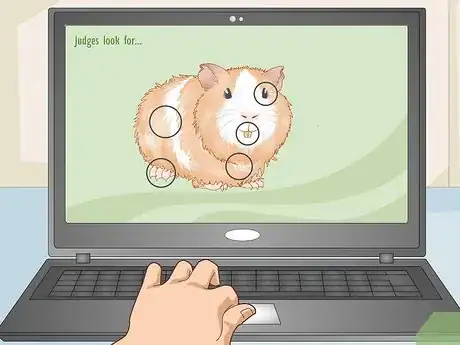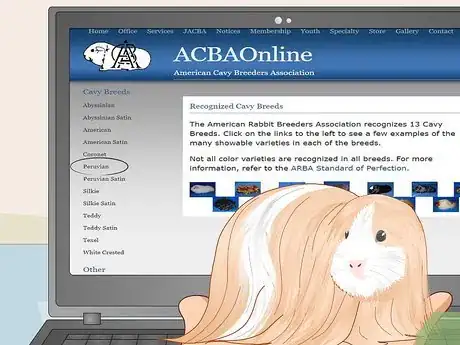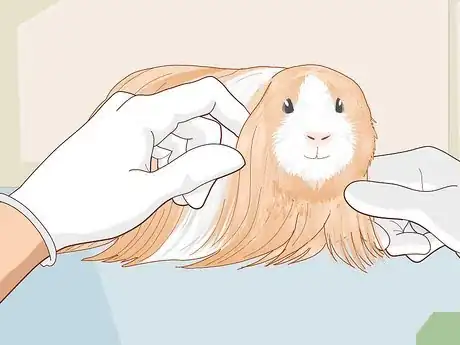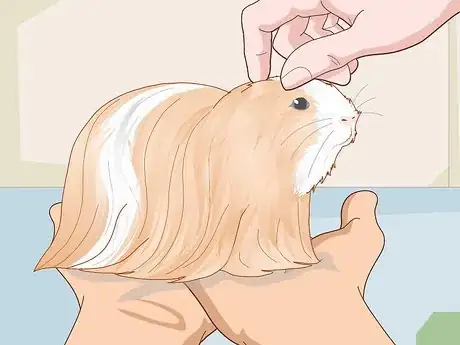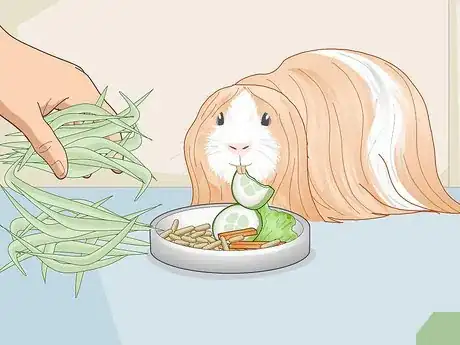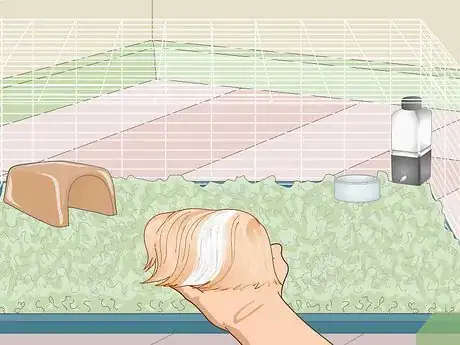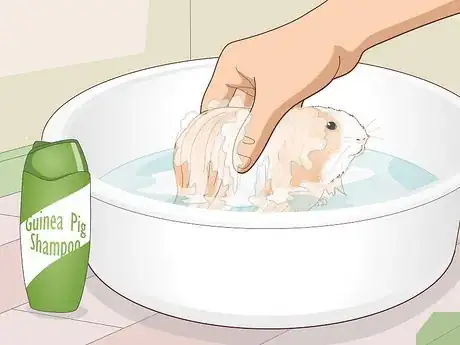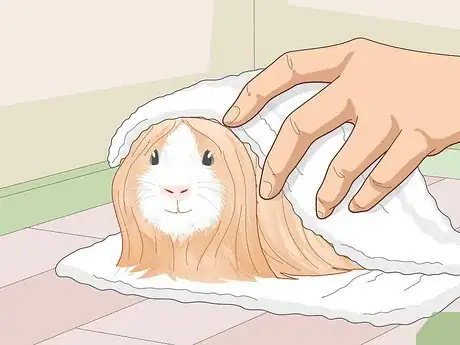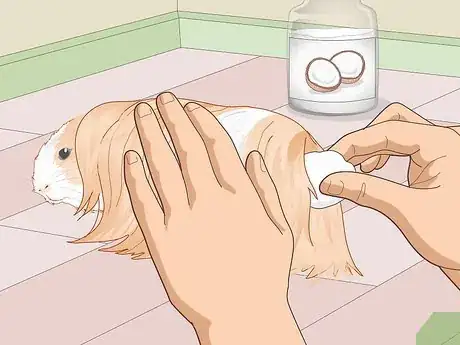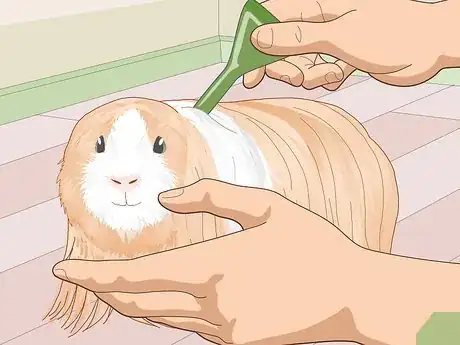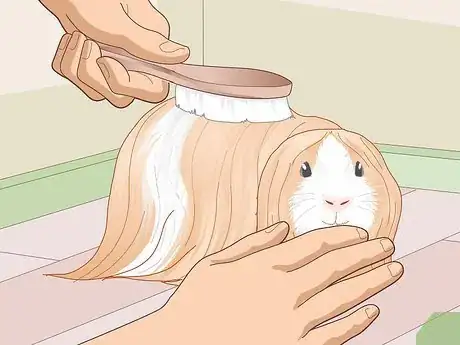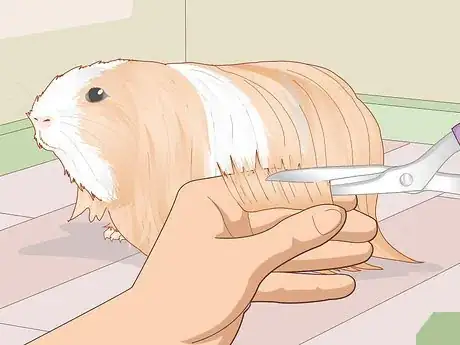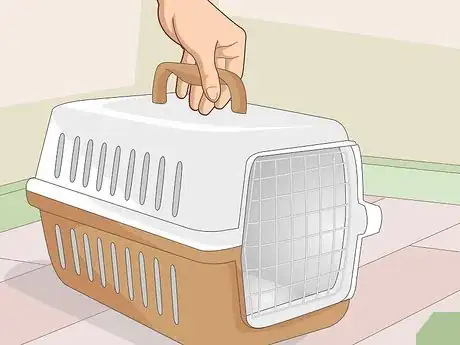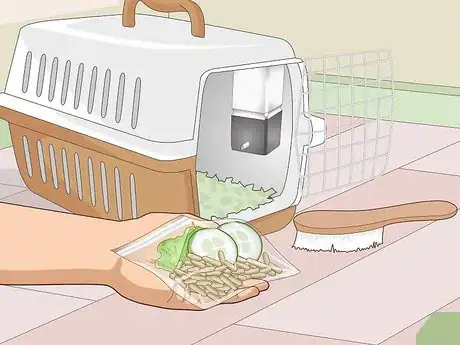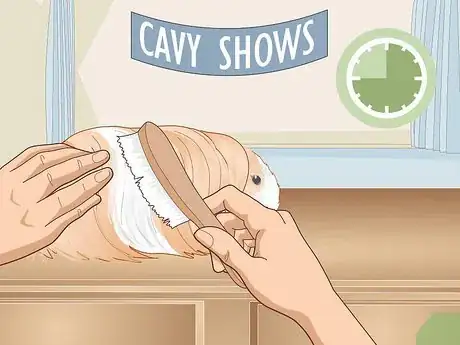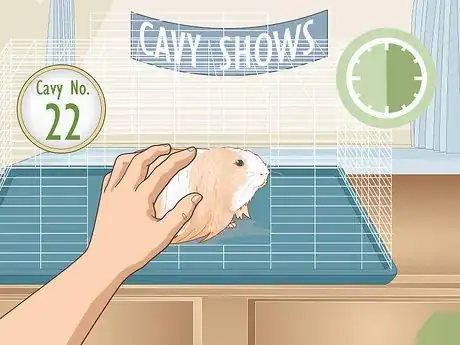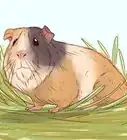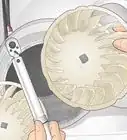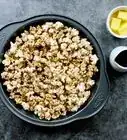wikiHow is a “wiki,” similar to Wikipedia, which means that many of our articles are co-written by multiple authors. To create this article, 13 people, some anonymous, worked to edit and improve it over time.
There are 13 references cited in this article, which can be found at the bottom of the page.
This article has been viewed 5,681 times.
Learn more...
One of the biggest shows in the U.S is the American Cavy Breeders Association (ACBA) which are held annually in each region. The quality of your guinea pig is determined by the judges based on a comparison of its standard; a set of rules that defines the ideal individual of each accepted breed.[1] Appearance and good health should be the main priority of your guinea pig. Continue reading below to learn how to prepare your guinea pig for a show.
Steps
Registering Your Guinea Pig for a Show
-
1Find a show held by ACBA, 4-H, or FFA. Cavy shows sanctioned by 4-H, or FFA typically take place at state or district fairs. ACBA organises shows all over the U.S.
- The American Cavy Breeders Association has a full list of shows on their website.
-
2Fill out an entry form. Typically it is required that you send in your entries a week or so before the show date. On the entry form, you will be asked the class number, breed, age, colouration, name, and date of birth of your cavy.Advertisement
-
3Enter your guinea pig in the appropriate class. The class type of your cavy is determined by their breed, age and colouration. Only purebred guinea pigs are eligible for entry. Mixed breeds are typically not recognised.
-
4Review the shows judging procedures and schedule. Cavies are typically not evaluated based on the judge's preference but are judged based on the comparison of its standard breed. Your judges will be inspecting your guinea pigs eyes, mouth, teeth, fur, feet, colouration, patterns, markings, and weight.
- Check what is expected of your guinea pig on the day. Most cavies are expected to be able to stay in one spot. Your guinea pig must be docile; otherwise, your judge may not be able to examine them accordingly.
Conditioning Your Guinea Pig
-
1Ensure your guinea pig is of a recognised standard. The American Cavy Breeders Association recognises 13 distinct breeds that are eligible for entry in sanctioned shows.[2] The quality of an animal is determined by comparing the cavy to its standard; a set of rules that defines the ideal individual of each accepted breed.[3]
- While mixed breeds make fine pets, they aren't recognised by the ACBA, and therefore are not eligible for entry.[4]
-
2Have your guinea pig quality checked. Schedule an appointment with a well-trained veterinarian that specialises with guinea pigs a few days before registering to identify any signs of potential illness or health issues. The presence of recent injuries, parasites, illness, or disfigurements will disqualify your guinea pig from the competition.[5]
- A few symptoms to look out for include; loose stool, frequent coughing or sneezing, watery nose or eyes, laboured breathing, drooling, roughed up coat, lethargy, lack of appetite, and/or fur loss.[6]
-
3Have your guinea pig accustomed to being handled. While cavies are primarily judged according to their physical appearance, their behaviour towards the judge is also an important factor to consider. Your guinea pig will not only be observed and handled by the judges but be placed in a noisy and crowded environment as well. Tame your guinea pig at an early age and have them accustomed to being examined by placing your hands near their eyes, mouth, rump, and underside.
- Long-haired breeds are typically judged according to the quality of their coat, and are trained to stand still on top of a raised platform to better display their hair.[7]
- Short-haired breeds are instead taught to run the length of the table so that the judge can get a better idea of the overall shape and weight of your cavy.[8]
- For good measure, train your guinea pig to stay still, walk a certain distance, and to remain calm in an unsteady environment.
- Allowances are made for younger guinea pigs to be more skittish, as they are not expected to be as steady as adult guinea pigs which have had more show experience.[9]
-
4Feed your guinea pig a high-quality diet. Guinea pig's have a diet consisting of 80% hay, 15% vegetables, and 5% pellets.[10] Research their dietary needs using a reliable resource as a guide. Guineapiglynx.com has a range of extensive information covering basic guinea pig care.
- Grass hay is the main staple of their diet. Provide a fresh and unlimited bundle of hay each day for your guinea pigs to chew. Timothy, orchard, and meadow hay are popular varieties that can be fed to guinea pigs.[11]
- A fresh variety of vegetables should be fed daily. Each guinea pig requires one cup to keep them sustained. Bell peppers and grass are the only daily greens that can be fed on a day-to-day basis. Other vegetables must be limited 2-4 times a week, depending on their nutritional content. A few vegetables that guinea pigs can eat are; parsley, cucumber, spinach, corn, tomatoes, kale, broccoli, bok choy, and romaine lettuce.[12]
- Pellets are an essential part of your guinea pig's diet to improve their vitamin C intake, as they cannot produce vitamin C on their own. Guinea pigs require a 1/8 cup of pellets each day per pig. Oxbow adult guinea pig pellets are vet approved and recommended. Avoid pellets that contain seeds, grains or colourful pieces, as these are not healthy for your guinea pig.[13]
-
5Care for your guinea pig properly. Guinea pigs require plenty of attention and human interaction to maintain a healthy lifespan. Your first priority should be setting up a suitable home for your cavies to live. Poor living conditions can affect your guinea pig's health and appearance.
- Set up a 7.5 square feet cage for the minimum of 1-2 guinea pigs. Apply a lining of newspaper or puppy pads, and absorbent, dry bedding. Some popular bedding options include fleece, paper bedding, and wood shavings. Their cage should be spot cleaned daily and cleaned weekly to prevent ammonia build-up and urine scald or bumblefoot.
- Place a hideout in your guinea pig's cage. Plastic igloos or wooden huts are a few suitable options.
- Place food dishes and a water bottle inside your guinea pig's cage. You will need a medium-sized bowl for their vegetables, and a small-sized bowl for their pellets. Purchase a leak-resistant water bottle to attach to the side of their cage.
- Provide your guinea pigs with a few toys, such as chew toys, hay stuffers, ramps, tunnels and hammocks.
- Do not purchase a wire hay rack, wire hay ball, exercise wheel, or exercise ball for your guinea pig. These are restricted accessories that aren't suitable for guinea pig use, despite being advertised by pet companies.
Bathing Your Guinea Pig
-
1Fill a shallow washbasin with warm water. Pour 2 inches (5.1cm) of water into a container, ensuring the water reaches no higher than your guinea pig's feet. Water that is 90 to 100 °F (32 to 38 °C) is ideal.[14]
- Place a cloth on the base of the tub to prevent your guinea pig from slipping.
- Test the temperature of the water with your wrist.
- The Capricornia Cavy Club website recommends bathing your cavy a week before the show if he has short hair and up to two weeks if he is among the breeds with coarse hair, which include the Abyssinian variety.[15]
-
2Rinse your guinea pig with warm water. Using a small cup, or by scooping your hands, gently rinse water over your guinea pig's rump and body. Do not wet your guinea pig's face or ears.[16]
- Cup your hand behind your guinea pig's face to divert the water away from their face and ears.
- Use a dampened washcloth to gently clean your guinea pig's face.
-
3Apply a specially formulated guinea pig shampoo. Using a pea-sized application, gently massage the shampoo into your guinea pig's fur until a thick lather forms. Shampoo your guinea pig's entire coat, excluding the face and ears.[17]
- Thoroughly rinse the shampoo with warm water until the soap is completely removed.
- Guinea pig shampoo and conditioner is commercially available in most pet stores and veterinary clinics. Because guinea pig's have sensitive skin, baby, dog, and human shampoos are not suitable, as they can irritate their skin.[18]
-
4Thoroughly dry your guinea pig. Wrap your guinea pig in a warm towel, and gently pat and rub their fur to speed up the drying process. Place your guinea pig in a warm and dry area until their coat is completely dry.
- Alternatively, you can use a hairdryer on a low setting to dry your guinea pig. However, some guinea pig's may become scared of the intensity and noise of the hairdryer.
-
5Clean your guinea pig's grease gland. The grease gland is covered with fur and located at the base of their spine. Look for it about half an inch away from their genitals, where you'd imagine their tail to be.[19] Apply coconut oil to the area with a cotton wool pad, and gently rub it into the grease gland to loosen up the grease. Use a cotton ball to wipe away the grease and gently rinse with warm water.
- Trim around the grease gland if needed. This makes it easier to see the area, especially if your guinea pig is of a long-haired variety.
- Although male guinea pigs are more prone to grease build-up in this area, females can also have an active grease gland. It's important to clean this area to prevent build-up and infections from occurring.[20]
-
6Apply a flea dip product to your guinea pig's coat. Consult your veterinarian on the type of dip products that you can use on your cavy and the methods in which you should apply them.[21] Apply a dip product 1-2 weeks before you show your guinea pig to prevent a parasitic infestation of lice, fleas or mites.
Caring for Your Guinea Pig's Coat and Nails
-
1Purchase a pet brush or comb. Narrow-toothed combs are recommended for guinea pigs due to their fine hair. Wide-toothed combs may be ineffective, as they may not catch such fine hair between the teeth.[22]
- Hair combs specially designed for guinea pigs are commercially available in most pet stores; however, fine-toothed combs for cats can be used as well.[23]
- Bristle brushes are also popular choices to brush your guinea pig's coat.
-
2Comb your guinea pig's coat. Short-haired breeds typically do not need to be brushed more than once a week. Long-haired varieties, however, should be brushed several times a week to prevent matting and tangles.[24] If you do spot any knots, it's important to detangle them promptly to avoid ruining their coat.
- Pay attention to any lumps or bald patches on your guinea pig's skin as you brush. If you notice any abnormalities, contact your veterinarian.
-
3Trim your guinea pig's fur. Long-haired varieties, such as Peruvian and Sheltie breeds, will require trimming 3-4 days before the show. It's important not to butcher their coat. If you feel like you're inexperienced in coat trimming, pass your guinea pig off to a professional. There are two types of trimming that guinea pigs require; bottom or butt cutting, and overall coat maintenance and trim.[25]
- Bottom cutting is important for long-haired breeds to ensure their hair doesn't drag or become matted. It's suggested to cut their hair when it's wet as their coat is said to be easier to cut when the strands join together. Gently place the hair between two fingers, cut around the bottom and trim the hind legs.[26]
- There are multiple methods for overall trimming of the coat. Using hair trimming clips, work the coat in layers; clip the outer hair up to separate it from the undercoat. Hold the hair with your two fingers, and cut the bottom layer, removing clips as you go so you trim one layer at a time. Trim the fringe using the same method.[27]
-
4Cut your guinea pig's nails. Guinea pig's nails typically grow to a longer length then desires. It's important to maintain their nails by trimming them every few months and filing them back. To trim your guinea pig's nails, you must first identify the quick, which is the red blood vessel running through each nail. To identify the quick, shine a flashlight underneath the nail. Trim the nail gently up to the quick and file it back.[28]
- Guinea pig nails can be trimmed using baby clippers or nail trimmers commercially designed for small animals. Do not use dog nail trimmers, as these are too large to be used on guinea pigs.
- Keep a septic pen or cornflour near-by in case your guinea pig's nails happen to bleed. A septic pen (or cornflour) will stop the bleeding.
- Feed your guinea pig a piece of vegetable to distract them, and a treat to praise them afterwards. If your guinea pig is finicky, you may need to have someone hold them while you trim their nails.
Transporting Your Guinea Pig
-
1Transport your guinea pig in a small animal carrier. Purchase a carrier that is spacious, clean, and ventilated. Plastic cat carriers are popular choices when transporting your guinea pig to a show.
- Alternatively, you can transport your guinea pig in a cardboard box with ventilation holes. However, it is highly recommended to invest in a suitable carrier during the show.
-
2Line the carrier with newspaper. Place a few sheets of newspaper at the bottom of the carrier, and apply some wood shavings, shredded paper or fleece on top to create an absorbent base.
- Attach a leak-resistant water bottle to the side of the carrier, and place some hay and vegetables inside.
-
3Bring a list of supplies to the show. While wire cages are supplied by the association of the show, it is expected that you bring some items by yourself. For example:
- You will need a grooming kit to brush your guinea pig and make some final adjustments before the show if required.
- Bedding for your guinea pig, such as shredded paper or wood shavings.
- Food for your guinea pig, including hay, vegetables and pellets.
- Optionally, you can bring a water bottle to keep your guinea pig hydrated, however, water can be supplemented to your guinea pig through water retained vegetables, such as cucumber and lettuce.
-
4Brush your guinea pig's coat 45 minutes before the show. Using a narrow-toothed comb or bristle brush, gently brush through your guinea pig's coat to get rid of any dirt, bedding or tangles.
-
5Place your guinea pig in their cage 30 minutes before the show starts. Your guinea pig will remain inside their pen throughout the judging process. You should be assigned a cage when you register. Check the judging schedule for your type and class to find out what time your guinea pig needs to be in their pen.
Warnings
- Guinea pig's have to be healthy to able to enter in a cavy show. If your guinea pig is ill, they are immediately disqualified from the competition.⧼thumbs_response⧽
- Do not bathe your guinea pig if they are sick or suffering from a respiratory illness.⧼thumbs_response⧽
- Keep a close eye and a hand on your guinea pig. Grooming is stressful and s/he could easily get too irritated and run away.⧼thumbs_response⧽
References
- ↑ https://wheeklyreader.wordpress.com/2013/05/14/cavy-shows-basics-for-beginners/
- ↑ https://wheeklyreader.wordpress.com/2013/05/09/recognized-u-s-cavy-breeds-2/
- ↑ https://wheeklyreader.wordpress.com/2013/05/14/cavy-shows-basics-for-beginners/
- ↑ https://wheeklyreader.wordpress.com/2013/05/09/recognized-u-s-cavy-breeds-2/
- ↑ https://wheeklyreader.wordpress.com/2013/05/14/cavy-shows-basics-for-beginners/
- ↑ https://www.petfinder.com/pet-care/small-and-furry-care/guinea-pig-basics-illness-warnings/
- ↑ https://wheeklyreader.wordpress.com/2013/05/14/cavy-shows-basics-for-beginners/
- ↑ https://wheeklyreader.wordpress.com/2013/05/14/cavy-shows-basics-for-beginners/
- ↑ http://www.britishcavycouncil.org.uk/Novice/Showing/nov-showing-intro.shtml
- ↑ https://guineapig101.com/guinea-pig-diet/
- ↑ https://www.guinealynx.info/diet.html
- ↑ https://www.guinealynx.info/diet.html
- ↑ https://www.guinealynx.info/diet.html
- ↑ https://www.abyssinianguineapigtips.com/how-to-bathe-a-guinea-pig/
- ↑ https://animals.mom.me/groom-guinea-pig-show-7927.html
- ↑ https://www.pets4homes.co.uk/pet-advice/can-i-give-my-guinea-pigs-a-bath.html
- ↑ https://www.abyssinianguineapigtips.com/how-to-bathe-a-guinea-pig/
- ↑ https://animals.mom.me/guinea-pigs-need-washed-2079.html
- ↑ http://www.calicavycollective.com/2013/09/cleaning-your-guinea-pigs-grease-gland.html
- ↑ http://www.calicavycollective.com/2013/09/cleaning-your-guinea-pigs-grease-gland.html
- ↑ https://animals.mom.me/groom-guinea-pig-show-7927.html
- ↑ https://www.petmd.com/exotic/grooming/grooming-care-your-guinea-pig
- ↑ https://www.petmd.com/exotic/grooming/grooming-care-your-guinea-pig
- ↑ https://www.petmd.com/exotic/grooming/grooming-care-your-guinea-pig
- ↑ https://www.guineapigsaustralia.com.au/grooming.htm
- ↑ https://www.guineapigsaustralia.com.au/grooming.htm
- ↑ https://www.guineapigsaustralia.com.au/grooming.htm
- ↑ https://www.petmd.com/exotic/grooming/grooming-care-your-guinea-pig
